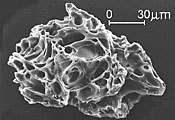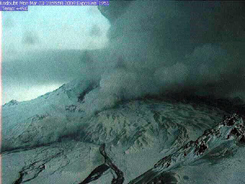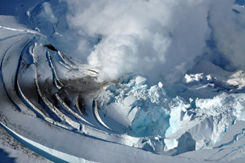
Beginning Sunday March 22, 2009 at approximately 22:38 AKDT, Redoubt Volcano produced a series of five explosive eruptions that each lasted from four to thirty minutes.
The glacier-covered Redoubt Volcano is one of many that line Alaska's southern shores. (Located 177 kilometers (110 miles) southwest of Anchorage)
The last eruption ended at 5:00 AM AKDT March 23. National Weather Service radar, pilot reports, and analysis of satellite imagery suggest that these events produced ash clouds that reached 60,000 ft above sea level (asl), with the bulk of the ash volume between 25 - 30,000 ft asl. Traces of ash fall have been reported in Skwentna, Talkeetna, Wasilla, and Trapper Creek.
Eruption Timeline
2009-04-09 06:49:22
The eruption of Redoubt continues. Redoubt remains at aviation color code ORANGE and alert level WATCH.
Elevated seismicity at Redoubt continues with many small, discrete earthquakes.
2009-04-09 05:30:55
The eruption of Redoubt continues. Redoubt remains at aviation color code ORANGE and alert level WATCH. Elevated seismicity at Redoubt continues with many small, discrete earthquakes.
2009-03-26 12:38:35
A large eruption of Redoubt volcano occurred at 09:24 AKDT (17:24 UTC) this morning. National Weather Service reports the cloud height to be at least 65,000 ft above sea level and pilot reports indicated a plume height of 60,000 ft. Since this event, a few smaller events have occurred but these did not generate plumes above about 20,000 feet.
The eruption at 9:24 AKDT also produced a lahar in the Drift River valley that was detected by seismic instruments.
An ashfall advisory is in effect until 4 PM for the western Kenai Peninsula. High level ash (above 30,000 feet) is forecast to pass over Anchorage, but is not expected to produce ash fall.
2009-03-25 16:40:44
The last known ash emission was at 5:12 AKDT this morning. The plume from this event did not extend above about 15,000 feet.
Based on the level of seismic activity, AVO has lowered the aviation color code to ORANGE and the volcanic alert level to WATCH.
2009-03-24 19:16:55
Seismic activity at Redoubt remains elevated and low-amplitude volcanic tremor and small discrete earthquakes continue. No additional ash emissions have occurred since last evening.
2009-03-24 13:35:58
Seismic activity at Redoubt remains elevated and low-amplitude volcanic tremor and small discrete earthquakes continue. No additional ash emissions have occurred since last evening.
An AVO observation and gas measurement flight is currently underway.
2009-03-24 05:15:51
Seismicity has remained unchanged for the past few hours.
The National Weather Service ashfall advisory is no longer in affect.
2009-03-23 16:35:16
The eruption of Redoubt volcano continues and the color code and volcano alert level remains at RED/WARNING. Seismic activity remains elevated, but has declined slightly over the past several hours. The activity consists mostly of volcanic tremor with some discrete events.
2009-03-22 23:02:22
An eruption of Mt. Redoubt began at approximately 22:38 AKDT, March 22, 2009 (0638 UTC). AVO is raising the aviation color code to Red and the alert level to Warning. Initial height of the eruption cloud is estimated at less than 20,000 ft above sea level at present. Further reports will be issued as more information becomes available.
Volcano Color Code Definitions
-
GREEN: Volcano is in typical background, noneruptive state or, after a change from a higher level, volcanic activity has ceased and volcano has returned to noneruptive background state.
- YELLOW Volcano is exhibiting signs of elevated unrest above known background level or, after a change from a higher level, volcanic activity has decreased significantly but continues to be closely monitored for possible renewed increase.
- ORANGE: Volcano is exhibiting heightened or escalating unrest with increased potential of eruption, timeframe uncertain, or eruption is underway with no or minor volcanic-ash emissions [ash-plume height specified, if possible].
- RED: Eruption is imminent with significant emission of volcanic ash into the atmosphere likely OR eruption is underway or suspected with significant emission of volcanic ash into the atmosphere [ash-plume height specified, if possible].
Volcanic Activity Alert Level Definitions
- NORMAL: Volcano is in typical background, noneruptive state or, after a change from a higher level, volcanic activity has ceased and volcano has returned to noneruptive background state.
- ADVISORY: Volcano is exhibiting signs of elevated unrest above known background level or, after a change from a higher level, volcanic activity has decreased significantly but continues to be closely monitored for possible renewed increase.
- WATCH: Volcano is exhibiting heightened or escalating unrest with increased potential of eruption, timeframe uncertain, OR eruption is underway but poses limited hazards.
- WARNING: Hazardous eruption is imminent, underway, or suspected.
Ashfall is Dangerous!
Ash falls vary widely in intensity, size of the ash particles, and the degree to which light from the sun is obscured or blocked completely. Because of the unexpected darkness during daylight hours, loud thunder and lightning, and the sometimes strong smell of sulfur during an ash fall, many people describe the experience as eerie and frightening, disorienting and confusing, or dreadful. In extreme ash fall, for example when ash thickness is more than 5-10 cm (2-4 in), people may feel stunned and fearful of the conditions, have a difficult time breathing if a well-sealed shelter is not available. If caught outside during low visibility, people may become lost or extremely disoriented.
If heavy ash fall continues for 12-60 hours or more, roofs may collapse under the weight of the ash, resulting in more confusion, injuries, and even death.
Volcanic Ash is Not Soft or Fluffy

Small jagged pieces of rocks, minerals, and volcanic glass the size of sand and silt (less than 2 millimeters (1/12 inch) in diameter) erupted by a volcano are called volcanic ash. Very small ash particles can be less than 0.001 millimeters (1/25,000th of an inch) across. Volcanic ash is not the product of combustion, like the soft fluffy material created by burning wood, leaves, or paper. Volcanic ash is hard, does not dissolve in water, is extremely abrasive and mildly corrosive, and conducts electricity when wet.
Volcanic ash is formed during explosive volcanic eruptions. Explosive eruptions occur when gases dissolved in molten rock (magma) expand and escape violently into the air, and also when water is heated by magma and abruptly flashes into steam. The force of the escaping gas violently shatters solid rocks. Expanding gas also shreds magma and blasts it into the air, where it solidifies into fragments of volcanic rock and glass. Once in the air, wind can blow the the tiny ash particles tens to thousands of kilometers away from the volcano.
What Should I Do About Ash?
Everyone in an ash fall zone will be exposed to the effects of volcanic ash. Tiny volcanic ash can infiltrate all but the most tightly sealed buildings and machinery and is often small enough (less than 10 microns) to be inhaled deeply into the lungs. Ash fall over extensive areas can prevent travel for days because of poor visibility, slippery roads, and damage to vehicles. Power outages may occur before, during, and after an ash fall either due to equipment failure or because power facilities are temporarily shut down to prevent damage. Afterwards, wind and human activity can stir up ash for weeks to years.
In most situations, acting on a few general principles will reduce the effects of ash and make clean-up operations easier. These principles apply to households, businesses, and communities.
General principles
- Keep ash out of buildings, machinery, vehicles, downspouts, water supplies, and wastewater systems (for example, storm drains) as much as possible. The most effective method to prevent ash-induced damage to machinery is to shut down, close off or seal equipment until ash is removed from the immediate environment, but this may not be practical in all cases, especially for critical facilities.
- Minimize exposure to airborne ash by using dust or filter masks (or a wet cloth, for example a handkerchief) and minimizing travel.
- Coordinate clean-up activities with neighbors and community-wide operations (learn the clean-up guidelines and instructions of your local community and leaders). After an ash fall, promptly notify building owners to remove ash from roofs in a timely manner to prvent streets from being repetitively cleaned.
- Stay informed of volcanic activity in your area, especially during a period of unrest, and know what to expect, including the type of eruptions that can occur and how much warning is possible for ash fall in your area once an explosive eruption occurs. Learn about evacuation procedures, if any, in your area.
- Prepare for an emergency by having critical provisions and supplies needed to support your family, business, or community for at least several days; for example, food, water, medicine, and shelter, dust masks and other personal protection equipment, spare filters and parts for machinery and vehicles.
- Develop and test a contingency plan that can be used in a variety of emergencies, but not necessarily focused on volcanoes.
- Provide information frequently and directly to the public about volcanic ash, including instructions for participating in clean-up operations.
Redoubt Background

The glacier-covered Redoubt Volcano is one of many that line Alaska's southern shores. Located 177 kilometers (110 miles) southwest of Anchorage, Redoubt is one of the peaks in the scenic Chigmit Mountain Range that frames the western side of Cook Inlet in Lake Clark National Park and Preserve. Redoubt is also one of the most active of the Cook Inlet volcanoes. It last erupted in 1989 and 1990, sending a plume of ash into the atmosphere large enough to interfere with air traffic. At the time, the eruption was one of the costliest eruptions in U.S. history, said Joel Hard, superintendent of Lake Clark National Park and Preserve. In late January 2009, the volcano started to rumble once again.
According to the Alaska Volcano Observatory, volcanic tremors started to shake Redoubt, most likely caused by fresh magma rising in the volcano. As of February 10, 2009, the increased activity had continued, but the volcano had not yet erupted. At that time, the Alaska Volcano Observatory warned of four possible outcomes: the volcano could quiet without an eruption; a small eruption could occur; a larger explosive eruption could occur; or the flank of the volcano could collapse in a massive landslide such as the one that occurred when Mount St. Helens erupted in 1980. Based on past activity at Redoubt, the Alaska Volcano Observatory expected a small to moderate eruption.
 Print
Print Email
Email








